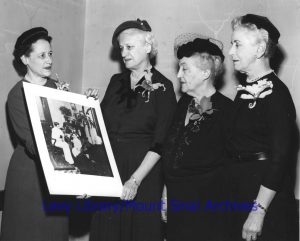This is a guest blog post by summer intern, Lily Stowe-Alekman. Lily is a junior at Smith College where she studies History, Archives, and the Study of Women and Gender.
Even before given access to traditional pathways of change, women at The Mount Sinai Hospital have worked to make change in the institution. From the opening of The Mount Sinai Hospital in 1855, the wives and daughters of the Board of Trustees worked to provide services in order to provide comfort to patients and to address their social and emotional well-being. By 1917, the first year that women were allowed on the Board, the role of women, and their expectations of that role, had substantially changed. The growing power of women was expressed by the creation of their own organization to exert influence over the life of the Hospital, the Social Service Auxiliary. And according to Helen Rehr, DSW, the second Edith J. Baerwald Professor of Community Medicine (Social Work), they were a force to be reckoned with.1 When prompted in an interview about the Auxiliary, “…they weren’t social butterflies having their tea. That’s not an image you would draw,” Rehr responded “Not these women, never. In the 28 years that I’ve known them I don’t recall having tea with them. No, they were women who came with a commitment to the social organization.” Hortense Hirsch, who served on the Auxiliary Board and Board of Trustees as one of the first woman able to be a Trustee, is a powerful example of the trailblazing women of the Auxiliary Board.

A portrait of Hortense Hirsch, circa 1960.
In 1923, Mrs. Hortense Hirsch (1887-1990) began her work with the Social Services Auxiliary (today’s Auxiliary Board), of which she would continue to be a member for sixty-five years, including a tenure as president from 1951-1956. From there, she was elected to the Board of Trustees in 1932, where she remained until becoming an honorary trustee in 1986. She sat on several committees of the Board, including as a member of the Committee on Building Maintenance and Equipment, Vice-Chairman of the Committee on Social Service, Chairman of the Committee on Convalescent Care, and as a member of the Committee on Ladies’ Auxiliary. Hirsch was president of the Neustadter Home for Convalescents beginning in 1937 when the Home affiliated with Mount Sinai, until she stepped down from the post in 1953.

A photograph of (from left to right) Helen Benjamin, member of the Women’s Auxiliary Board; Mrs. Edith Lehman, the first President of the Auxiliary Board from 1916-1917, Mrs. Ruth Cook, President from 1917-51; and Mrs. Hortense Hirsch, the presiding President of the Board at the fiftieth anniversary of the Auxiliary Board in 1956. Helen Benjamin holds a picture of the first social work volunteer from 1907.
Hortense Hirsch lived to be 103 years old, and by all accounts she remained steadfast in her dedication to social work and volunteerism for her whole life. After she graduated from Smith College in 1907 at the age of 19, she married Walter Hirsch and then moved to New York City in 1909. She began her work as a volunteer at Mount Sinai in 1917. The Federation of Jewish Philanthropies later referred to her as the “honorary ‘Dean of Social Work Volunteers.’” As a thoroughly involved volunteer and then Auxiliary Board member, Hirsch dedicated many hours to the hospital. Dr. Helen Rehr remarked in 1982, “The demands on her were great, but she always rose to it. There was no question on that score.”

Portrait of Hortense Hirsch, circa 1976.
Hortense Hirsch’s personality leaps off the pages of archival materials. When at Smith College, she maintained her own horse and buggy, which was against the rules, by paying a farmer for boarding, effectively evading the administration. In a New York Times article documenting her 100th birthday celebration, her daughter Carol Kridel told them, that while Hirsch was too ill to attend and she had to stay in bed, she was still “wearing a pink bedjacket and a pink bow in her silver hair.” The article also includes a story of Hirsch “[coming] to her 85th birthday and [tossing] her skirts high to show she approved of the latest rage—hotpants.”
Hortense Hirsch’s work on the Social Service and Women’s Auxiliary Board helped to transform the hospital. She worked tirelessly as a volunteer and board member. Hirsch’s work and legacy came from and continued those of the women who originally found pathways to affect changes at The Mount Sinai Hospital in the late 1800s. Hirsch served on the Board of Trustees, an opportunity that was not available to the women of previous generations. As Dr. Helen Rehr stated, “the Mrs. Hirsches are an outgrowth of that group of women who were the wives of the board of trustees” and ultimately transformed the hospital in the process.
